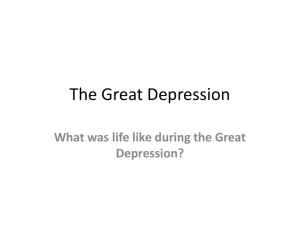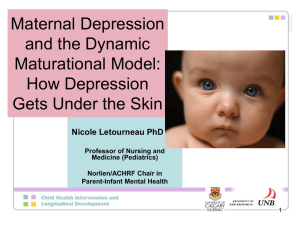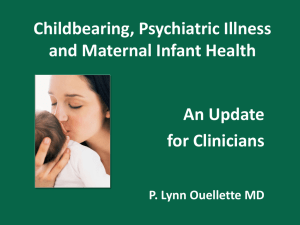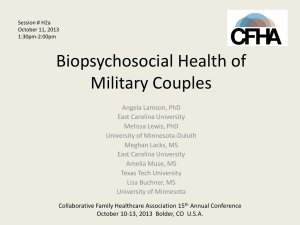Maternal Depression Final Presentation
advertisement
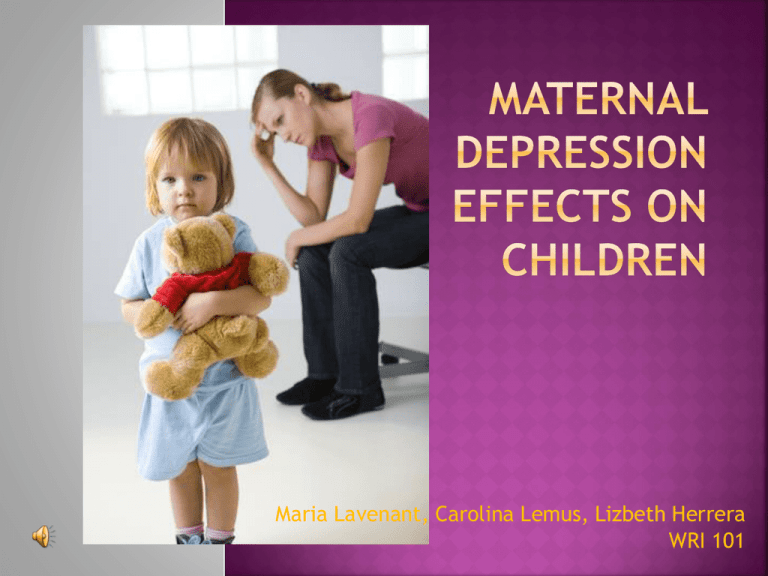
Maria Lavenant, Carolina Lemus, Lizbeth Herrera WRI 101 Depression affects many people. Young, fertile women. Parenting is difficult for women with depression. Children of depressed mother’s can develop similar symptoms. Low income Child Protective Services Low marital satisfaction Interactions with the mother Developmental stages Internalizing problems: Sleeping problems Low self-esteem Withdrawn behavior Interactions with peers and others Verbally Non-verbally Externalizing Isolation Aggression Anxiety problems: Disorders illustrate the interplay between personal and social factors. Children with ADHD less likely to develop Conduct Disorder Children interact in a hostile way towards peers Maternal depression has negative effects on a child’s personal and social well-being that can lead into adulthood. Limitations Marital health Intelligence Low income communities Future prevention and intervention programs Help parents manage emotions Positive parenting skills Focus in reducing maternal depression Reduce internalizing and externalizing problems Ways to improve child-mother relation. Databases Psycharticles Pubmed Csa: social sciences Difficulty separating personal and social well-being Alpern, L. & Lyons-Ruth, K. (1993). Preschool children at social risk: Chronicity and timing of maternal depressive symptoms and child behavior problems at school and at home. Development and Psychopathology, 5, 371-387. Retrieved from http://journals.cambridge.org/action/displayJournal?jid=DPP Beach, S. R. H., & O’Leary, K. D. (1993). Dysphoria and marital discord: Are dysphoric individuals at risk for marital maladjustment? Journal of Marital and Family Therapy, 19(3), 355-368. Retrieved from http://www.jmft.net/ Brennan, P. A., LeBrocque, R., & Hammen, C. (2003). Maternal depression, parent-child relationships, and resilient outcomes in adolescence. Journal of American Academy of Child and Adolescent Psychiatry, 42(12), 1469-1477. doi: 10.1097/01.CHI.0000091509.46853.7c Bureau, J., Easterbrooks, M. A., & Lyons-Ruth, K. (2009). Maternal depressive symptoms in infancy: Unique contribution to children’s depressive symptoms in childhood and adolescence? Developmental and Psychopathology, 21, 519-537. doi:10.1017/S0954579409000285 Chronis, A. M., Pelham Jr., W. E., Baumann, B. L., Kipp, H., Lahey, B. B., Williams, S. H., Jones, H. A., & Rathouz, P. J. (2007). Maternal depression and early positive parenting predict future conduct problems in young children with attention-deficit/hyperactivity disorder. Developmental Psychology, 43(1), 70-82. doi: 10.1037/0012-1649.43.1.70 Davis, N. M. (2005). Depression in children and adolescents. Journal of School Nursing, 21(6), 311-317. doi: 10.1177/10598405050210060201 Duggan, A. K., Cassidy, J., Berlin, L. J., Burrell, L., & Tandon, S. D. (2009). Examining maternal depression and attachment insecurity as moderators of the impacts of home visiting for at-risk mothers and infants. Journal of Consulting and Clinical Psychology, 77(4), 788-799. doi: 10.1037/a0015709 Feder, A., Alonso, A., Tang, M., Liriano, W., Warner, V., Pilowsky, D., Barranco, E., Wang, Y., Verdeli, H., Wickramaratne, P., & Weissman, M. M. (2009). Children of low-incomed depressed mothers: Psychiatric disorders and social adjustment. Depression and Anxiety, 26, 513-520. doi: 10.1002/da.20522 Hay, D. F., Pawlby, S., Angold, A., Harold, G. T., & Sharp, D. (2003). Pathways to violence in the children of mothers who were depressed postpartum. Developmental Psychology, 39(6), 1083-1094. doi: 10.1037/00121649.39.6.1083 Leckman-Westin, E., Cohen, P. R., Stueve, A. (2009). Maternal depression and mother-child interaction patterns: Association with toddler problems and continuity of effects to late childhood. Journal of Child Psychology and Psychiatry, 50(9), 1176-1184. doi:10.1111/j.1469-7610.2009.02083.x Lee, C. M., & Gotlib, I. H. (1991). Adjustment of children of depressed mothers: A 10 month follow-up. Journal of Abnormal Psychology, 100(4), 473477. Retrieved from http://www.apa.org/journals/abn/ Morrel, T. M., Dubowitz, H., Kerr, M. A., & Black, M. M. (2003). The effect of maternal victimization on children: A cross-informant study. Journal of Family Violence, 18(1), 2941. Retrieved from http://www.springerlink.com/content/0885-7482 Pawlby, S., Hay, D.F., Sharp, D., Waters, C.S., & O’Keane, V. (2009). Antenatal depression predicts depression in adolescent offspring: Prospective longitudinal community-based study. Journal of Affective Disorders, 113(3), 236-243. Retrieved from http://www.elsevier.com/wps/find/journaldescription.cws_home/506077/description#des cription Park, J. M., Solomon, P., Mandell, D. S. (2006). Involvement in the child welfare system among mothers with serious mental illness. Psychiatric Services, 57(4), 493-497. Retrieved from http://psychservices.psychiatryonline.org/ Shaw, D. S., Connell, A., Dishion, T. J., Wilson, M. N., & Gardner, F. (2009). Improvements in maternal depression as a mediator of intervention effects on early childhood problem behavior. Development and Psychopathology, 21, 417-439. doi:10.1017/S0954579409000236 Schwebel, D. C., & Brezausek, C. M. (2008). Chronic maternal depression and children’s injury risk. Journal of Pediatric Psychology, 33(10), 1108-1116. doi:10.1093/jpepsy/jsn046 Stein, A., Malmberg, L. E., Sylva, K., Barness, J., Leach, P., & the FCCC Team. (2007). The influence of maternal depression, caregiving, and socioeconomic status in the post-natal year on children’s language development. Child: Care, Health and Development, 34(5), 603-612. doi:10.1111/j.1365-2214.2008.00837.x Tully, E. C., Iacono, W. G., & McGue, M. (2008). An Adoption study of parental depression as an environmental liability for adolescent depression and childhood disruptive disorders. American Journal of Psychiatry, 165(9), 1148-1154. Retrieved from http://ajp.psychiatryonline.org For the presentation we collaborated in putting the slides and text together. Maria inserted the images and worked on the Introduction, Previous Studies and the Personal & Social slides. Carolina worked on Personal well-being, Methodology, and Future studies slides. Lizbeth worked on the Social well-being, Conclusion, and limitation slides.





